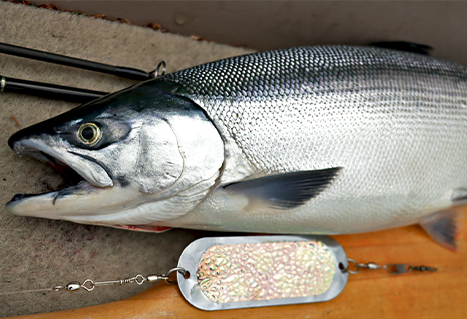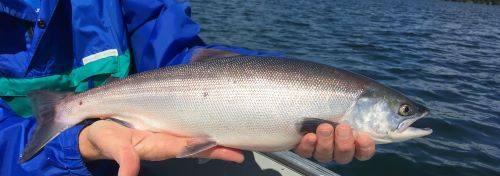How It Once Was
The year was 1980, and fishing in Kootenay Lake was at its prime. Not only were there opportunities to catch “Gerrards” (some of the world’s largest rainbow trout), but populations of West Arm kokanee were at their peak. I was merely 13, but I remember a particular day as if it were yesterday.
Dawn broke as our boat slowly approached the narrows at Sunshine Bay. A few boats were already anchored in line where the narrows widened into the bay. Soon, around 20 boats were anchored side-by-side. With lures set adrift in the current surging through the narrows, we waited for the inevitable schools of kokanee to swim past. Weighing between one and two kilograms (two to four pounds), these were not ordinary kokanee.
Suddenly, the boat directly to our right hooked up. After a spirited battle, our neighbour netted a beautiful kilogram-plus kokanee. And shortly after he got his gear back out, I looked over to see his rod bent over again.
After watching this cycle repeat itself several more times in quick succession, I lost all concentration on my own angling, and became fixated on what was happening in the next boat. I couldn’t see any difference between his gear and ours, but the rest of us only caught a fraction of his kokanee. It was like we were fishing two different lakes, but we were only three metres (10 feet) apart.
I figured out two things coming from that day on Kootenay Lake. First, my life goal: to become a fisheries biologist. And second: I wanted to be “that guy.”
Kokanee Fishing Today
Fast-forward over thirty years later. While some things have changed dramatically, others have remained the same. In the 1980s, the West Arm kokanee fishery collapsed from a combination of overharvesting and a little-known introduced creature called the mysid shrimp – but the fishing dominance demonstrated by some individual kokanee anglers has not. In those thirty years of fishing various Interior kokanee lakes, I still see the same thing: one boat catching fish after fish, with the others circling closer and closer, and looking on enviously. Why?
Know Your Kokanee and Its Habitat
As spring and summer progress, understanding the seasonal variations of both a kokanee lake and the fish’s post-ice-off cycle is critical. While primarily pelagic, kokanee in highly productive lakes take advantage of the natural cycles of food abundance.

Early Spring
Early in the spring, kokanee are able to move throughout a lake because of the colder water temperatures. The fish will not only forage on growing daphnia populations, but will travel into the shallows to take advantage of prolific chironomid and mayfly hatches. The traditional angler, fishing for rainbow trout with chironomids and mayfly imitations, can also have tremendous action on kokanee as schools feed in the shallows. When hatches are abundant, the kokanee troller fishing deeper waters can become frustrated, as the fish have probably disappeared from the centre of the lake.

Fish for kokanee much as you would for rainbows: anchor in a location where chironomids are hatching, and use a floating fly line with a strike indicator. The main difference between chironomid-fishing for kokanee versus trout is that kokanee will take chironomids at varying depths. While you might anchor in six metres (20 feet) of water and expect trout closer to the bottom, you can catch kokanee as little as a metre (three feet) down. Since kokanee do not tolerate warm water, this period of shallow-water fishing is brief. Rainbow trout can withstand increasing temperatures to feed on extended insect hatches, but kokanee abandon shallow water as the lake warms.
Late Spring
In May and June, after rising shallow-water temperatures have forced kokanee to return to the deeper portions of a lake, you can catch them using gang trolls and dodgers trailing almost any kind of small lure (like spoons, flies, and hoochies). This is the time most anglers experience the greatest success. Fish all depths from the surface down. The peak fishing periods are dawn and dusk, but kokanee will forage throughout the day.

Kokanee inhabit large areas of the lake that are within their temperature tolerance. They are now concentrated in big schools and feeding heavily, aggressive and full of fight. When you hook one, or notice a fellow angler catching one, note where; with what lure (including the colour); the trolling speed; and even your direction of travel. You stand a much greater chance if you replicate all the conditions, even if you can’t understand why you are catching fish.
Ever notice how the same rod will catch fish after fish, while the rod on the other side of the boat with essentially the same set-up catches none? Don’t wait, change: get one rod catching fish, and keep adjusting the set-up, lures, and depths on the other rod until its productivity catches up to or surpasses the first. If other people are catching fish and you’re not, again, don’t wait; change.
Summer
As spring turns to summer, warmer water forces kokanee to go deeper. The advantage, however, is that kokanee are now schooled tightly.
Small Interior lakes warm much faster than the larger reservoirs where most people fish for kokanee. Warm water sits in a layer on top of the cold water, creating what lake biologists call the “thermocline.” Development of the thermocline usually starts sometime in June, but it can begin as early as May or as late as July. Once the thermocline sets up, kokanee tend to inhabit the deeper portions of the lake below it.
The optimum depth to fish is just below the thermocline: where the cold and warm waters meet, a current forms that concentrates food. Having a depthsounder will greatly improve your chances of finding schools of kokanee, as you can often see the collecting food on your sounder as a line. Kokanee will sit right below this line and feed. In a kokanee lake, the thermocline is usually found at depths between six and nine metres (twenty to thirty feet) – six metres on bigger, deeper lakes like Bridge, and as deep as nine metres on shallower, smaller lakes like Deka and Sulphurous.

In summer, kokanee are what is called “crepuscular” – that is, most active at dawn and dusk. At these times, the zooplankton they feed on are most available, and the kokanee themselves are least vulnerable to predators. What does this mean to you, the angler? Use the “one for three” rule: the number of bites you get in an hour at dusk or dawn will be reduced to a third when fishing in the middle of the day.
Kokanee do still bite all day, but the periods between when they bite get longer, and how hard they bite decreases during the day. The number of bites will continue to decrease as other daytime activities (like water skiing and power boating) occur.
Get your lures down to where the fish are using a small downrigger or lots of lead core line. Kokanee are attracted to slow-trolled dodgers and flashers. Use small 4/0 dodgers or micro-flashers in front of small lures (like flies, plankton hoochies, Apex high-action trolling lures, spoons, or Spin N Glos whose hooks are tipped with PowerBait, cooked shrimp, or maggots) on short leaders.

Specifics matter. You may catch fish at a depth of 21 feet but not at 23 feet; with an orange Apex but not a pink one. Focus on every detail, and by replicating your presentation, if you catch one kokanee you will probably catch many.
Later Summer
By the first week of August, kokanee are now much deeper, following the dropping thermocline. Schools are smaller, but the fish are reaching their biggest sizes. Almost sexually mature, they are probably not actively feeding, but will still strike lures out of aggression. Speed up your presentation to cover as much water as possible. Use high-action lures like small spoons and Apexes. Kokanee are still silvery-bright, but their skin is becoming more leathery for the upcoming spawn. The largest kokanee of the year, often found only in small schools or singles, will be caught at this time.
Take the time to understand what affects kokanee, along with the seasonal changes and ecology of a lake. You will become “that guy” – the kokanee angler everyone is watching – rather than the one who’s trying to figure it out.

Author: Mike Ramsay – Fisheries Biologist, Cariboo Region
Images: Owen Schoenberger, Ben Fougere, Craig Orvis, Brian Chan, Steve Olson.
